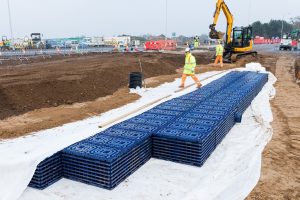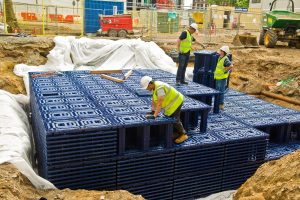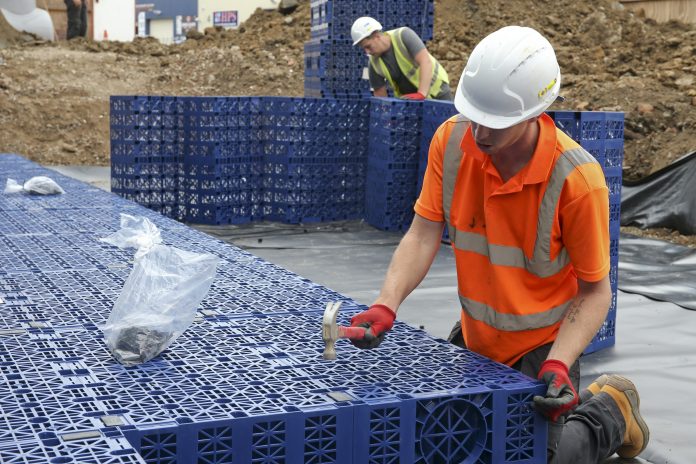New guidelines are being introduced to set standards for sustainable drainage systems (SuDS). Martin Lambley, product manager for stormwater at Wavin, looks at what we can expect to see – and what it will mean for SuDS adoption
The upcoming Sewers for Adoption 8 (SfA8) guidelines look set to change the face of drainage in the UK forever. For the first time, it will set out standards for sustainable drainage systems (SuDS), redefining the types of assets that water companies will be required to adopt and maintain. The big question is: are the new standards adequate and will they lead to higher quality surface water drainage coming through the planning system?
You only need to look at the widespread flooding of recent years to see that something needs to change with the urban drainage infrastructure in this country. We simply can’t keep trying to collect surface water from developments using pipes and releasing it into rivers. To this end, the latest version of Sewers for Adoption – a document that provides guidance for developers on the design and construction of sewers and related features that will be adopted by water and sewerage companies (WaSCs) in England – is for the first time setting out standards for sustainable drainage systems.
While SfA8 is expected to come into effect later this year, to allow sufficient time for WaSCs, planning authorities and developers to update their policies and procedures to comply with the new manual, a pre-implementation version was published in July 2018. Its publication provides a strong indication that WaSCs across England are now in the process of considering a range of vegetative and hard landscape SuDS techniques for adoption that considerably extend on the existing offering which, as mentioned, tends to just be oversized pipes and tanks.
Why is SfA8 so significant for SuDS in the UK?
SuDS are recognised as an important measure in not only ensuring flood resilience, but also for improving the urban environment, including air quality and biodiversity. Standards for implementing SuDS have been a long time coming, and while they have been used on developments in the UK since the mid-90s and became an integral part of policy back in 2014, they’re still not mainstream.
One of the primary reasons for this has been the lack of any formalised route to adoption, along with the perception that SuDS require additional maintenance when compared with conventional piped drainage systems.
SfA8 will provide this route in a way that allows water quality, amenity and biodiversity, as well as water quantity, to be properly considered and integrated into the surface water management and urban design process.
 SfA8 in practice
SfA8 in practice
Under SfA8, designers will need to fully consider installation, health and safety risk assessments, maintenance and access requirements of both hard and soft SuDS as part of their designs.
In terms of specific solutions, the new manual focuses on the benefits of swales and basins, as well as geocellular systems – modular crates that control surface water runoff either as a soakaway or a storage tank.
Changes to guidance outlined in the manual also include the five-metre rule for infiltration no longer being considered a hard rule, potentially allowing for infiltration close to buildings, and the requirement for significant freeboard on open SuDS structures, which could double or treble the available water storage.
These are all excellent steps in the right direction. However, as it stands, SfA8 doesn’t seem to go far enough in its promotion of SuDS, with key techniques being omitted, such as permeable pavements and green roofs.
There are also concerns over how strongly the standards can be enforced. Although the document is expected to be mandated by Ofwat, making it stricter than previous editions, the way it’s worded could create grey areas and wiggle room around certain aspects of adoption. For example, many water companies have been against geocellular tanks traditionally, claiming they are difficult to maintain or inspect compared with pipes. While this is not the case, old habits do die hard and moving towards a sustainable-first mindset won’t be easy without tight regulations.
 A sustainable future
A sustainable future
There’s no doubt that positive steps are being taken towards a more sustainable future for drainage. Last year, the government revealed its 25-year surface water action plan, albeit void of practical mechanisms. Now, with SfA8, this is stepping up a gear and we’re closer than ever to SuDS being universally adopted.
At Wavin, we’ve certainly experienced increased dialogue with water companies surrounding our SuDS solutions since the publication of the pre-implementation version of the manual – a clear indication that tangible change is afoot. What we need now as an industry is for all water companies to embrace SfA8 in its truest sense, put SuDS at the top of their agenda and, ultimately, rid SuDS of their specialist status and simply make them the norm. In a country where serious and often catastrophic floods are becoming ever more frequent, all drainage should be sustainable.
Wavin offers a wide range of sustainable drainage solutions suitable for a multitude of applications. To find out more, visit: www.wavin.co.uk.
Martin Lambley
Product manager for Stormwater
Wavin
Tel: +44 (0)1709 856300
Twitter: @WavinUK
YouTube: WavinUK
LinkedIn: Wavin Limited














